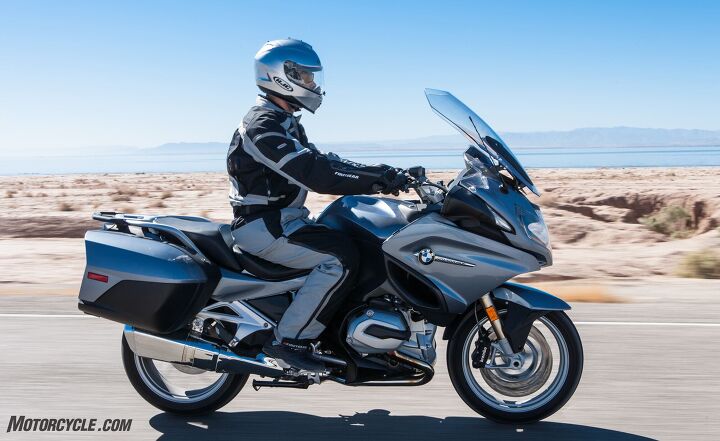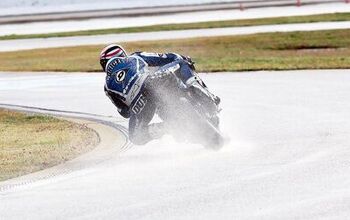New Rider: Riding A Motorcycle In The Wind

Relax and enjoy the dance
As a novice motorcyclist, you’re already well aware that a motorcycle is inherently unstable, and if you don’t intervene on its behalf, it could end up lying on its side. So, what do you do when you find yourself riding on a windy day? With a headwind, you just suck it up and deal with it if you don’t have a windshield. You probably won’t notice a tailwind, but it will extend your stopping distance. You’ll need to learn how to dance with the wind when it blows from the side.
The type of motorcycle you’re riding can have some effect on how you experience the wind. Bikes with handlebar-mounted fairings can interact with the wind when it is blowing from certain directions. In this case, slow down until the wind shifts. Sportbikes, with their solid sides, can also be affected by crosswinds. How you feel on a naked bike is largely a factor of the riding position and the direction of the breeze. Headwinds on a naked bike suck. There’s no way around it other than laying down on the tank, flat track-style.
The biggest issues for motorcyclists occur when the wind is blowing from the side. To a novice rider, it feels like it will push you off the road. And it will if you don’t take some action. Fortunately, in most cases, all you need to do is lean the bike into the wind slightly by countersteering. (Don’t know what countersteering is? Read this first.) In a light breeze, the effort is barely perceptible and somewhat automatic. You might not even notice that you are leaning into the wind. However, the key to proficient motorcycling is knowing exactly what you’re doing and why. As the wind speed picks up, your steering input with the windward hand will need to increase. In extremely high winds, you’ll be riding down the highway visibly leaning into the wind, and once you get the hang of it, you can have some fun.
How To Countersteer A Motorcycle
On days when the wind speed isn’t constant, you must maintain vigilance in order to stay in your lane, modifying your bike’s lean with the wind’s intensity. With a little practice, this will become second nature. However, don’t get overconfident. You still need to watch your surroundings and anticipate how they will affect the wind flow. For example, riding over a bridge on a highway doesn’t look like much, but it is enough to significantly reduce the wind’s force for a moment. If you’re ready, this is no big deal. You just lessen your steering input for a moment. Similarly, on interstates where the road cuts through the hills instead of going over them, the wind intensity can drop to near zero, or it can shift briefly to the opposite direction as you pass through the eddy created by the notch in the hill. Again, this is no big deal – if you’re ready for it. If you’re not, it can be terrifying.
Hills and large buildings aren’t the only things that can cause the wind to change directions or become turbulent. Passing a large truck can affect the wind in multiple ways. First, as you approach, the truck cuts the wind for you, and you’ll feel yourself being pulled faster into the low-pressure zone behind the truck. If you’re passing on the downwind side, the wind will drop to zero as you are beside the truck, but the thing that seems to catch riders out is that the wind’s force is multiplied as you reach the front of the truck and pass through the wave of air that it is pushing.
On a blustery day in which the direction of the wind is frequently changing, things can get pretty hectic as you react to every shift. In this situation, it might be prudent to slow down. Still, you’re just employing the same technique of leaning the bike into the wind.
Riding in windy conditions, like many aspects of motorcycling, is much easier once you understand what you need to do and when you need to do it. Take a day and ride a few hundred miles in the wind, and you’ll have mastered the technique.

Like most of the best happenings in his life, Evans stumbled into his motojournalism career. While on his way to a planned life in academia, he applied for a job at a motorcycle magazine, thinking he’d get the opportunity to write some freelance articles. Instead, he was offered a full-time job in which he discovered he could actually get paid to ride other people’s motorcycles – and he’s never looked back. Over the 25 years he’s been in the motorcycle industry, Evans has written two books, 101 Sportbike Performance Projects and How to Modify Your Metric Cruiser, and has ridden just about every production motorcycle manufactured. Evans has a deep love of motorcycles and believes they are a force for good in the world.
More by Evans Brasfield



































Comments
Join the conversation
Man that shot between Amarillo and dang near Ft Worth can get very windy.
"Motorcycles are inherently unstable." is factually incorrect. All of the physics involved in a moving motorcycle combine to force the motorcycle to do two things:
1. Stay perfectly vertical.
2. Continue in a perfectly straight line.
Those two facts are EXACTLY why you must learn to turn a motorcycle, because motorcycles don't want to turn, they want to go straight.
Yes, there is no question that the slower you go the more skill is required to make the bike do what you want it to do, but you really need to get your statements squared away.